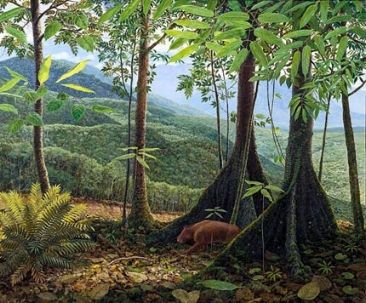
A TROPICAL RAINFOREST IN COLORADO?
Yes! Researchers are uncovering a tropical rainforest in Castle Rock, Colorado that existed 64.1 million years ago, in a time known as the early Paleocene. At this time, dinosaurs were long gone. They went extinct 1.4 million years earlier (or 65.5 million years ago) when a giant asteroid hit the earth near Mexico's Yucatan Peninsula, an event known as the Cretaceous-Tertiary (K-T) extinction. However, it wasn't just the dinosaurs that were affected by this catastrophic event. All forms of life were affected to some degree, including the forests. Many plant species were wiped out, never to be seen again. Immediately after the K-T event, very hearty plants like the ferns rebounded due to their ability to survive in harsh environments and acidic soils that were present following the K-T event. Scientists refer to this as the "fern spike" because ferns represented the overwhelming majority of plant species. Over time, other plants rebounded and evolved. However, it is believed that this took millions and millions of years.
At left, Artist Jan Vriesen's depiction of Castle Rock rainforest. (All rights reserved, Image Archives, Denver Museum of Nature & Science. Image used by permission of DMNS.)
IMPORTANCE OF DISCOVERY
This rainforest is a very exciting discovery because it may change many long-held views on how long it took plants to recover from the K-T extinction. At other fossil forest sites following K-T, the number of species is limited. However, the Castle Rock rainforest was thriving with an abundance of plant species. Since 1994, Dr. Kirk Johnson, curator of paleontology at the Denver Museum of Nature & Science (DMNS), Beth Ellis - DMNS project supervisor and a variety of others have recovered thousands of specimens representing over 100 species. This rainforest was exploding with diversity. In comparison to other early rainforests, it has a much greater number of species. In addition, the majority of the species discovered were completely unknown to science. Many fossil leaves are large and have long drip tips like plants that grow in tropical rainforests today.
Castle Rock's rainforest is an extremely valuable scientific discovery in terms of paleobotany (the study of fossil plants) and the general understanding of Earth's past for the following reasons:
- Colorado landscapes have changed dramatically throughout history. This is the first indication that an area in Colorado was once covered by tropical rainforest, perhaps one of the oldest rainforests in the world.
- The site is a great opportunity to study how quickly the environment rebounded after the extinction of dinosaurs 65.5 million years ago. It contains a rich variety of plant species which indicates a rapid evolution of tropical rainforests after the K-T extinction. [1]
- The northern latitude of this tropical rainforest may indicate a much higher global temperature during the lower Paleocene than previously believed. Research results obtained by studying the edges of the leaves (leaf margins), indicate that the mean annual temperature (MAT) was 22.2 Celsius [1], or 72.0 Fahrenheit. Other examples of Paleocene forests have shown temperature ranges of 11-18 C. Also, compare Castle Rock's rainforest temperature of 22.2 C to Denver's average annual temperature for 2001 of 11 C, or 51.3 F!
- The unusually large size of leaves found here (up to 1280 cm2) indicate large amounts of precipitation. Analysis of leaf area indicates that this rainforest received 225 cm of precipitation, or 88.5 inches (mean annual precipitation). Other examples of Paleocene forests have shown ranges of only 137-157 cm of precipitation. [1]
DISCOVERER
In 1994,
Colorado
Dept of Transportation (CDOT) paleontologist Steve Wallace began surveying
the hillside at Castle Rock in preparation for future road widening efforts.
When he found large leaf fossils, he contacted Kirk Johnson at the DMNS
and intensive research and discovery were underway.
CURRENT EFFORTS
Although excavation and research have been ongoing since 1994, a large scale project is currently underway by Denver Museum of Nature & Science staff and volunteers, with generous support and assistance from CDOT. A massive excavation and collection effort is going on today in Castle Rock. The specimens are cataloged, sealed and transported for storage in the Collections Room at the DMNS. The goal is to complete the excavation and recovery efforts at the site by Nov 2002. CDOT's discovery and funding have been instrumental in providing these valuable specimens and knowledge to the scientific community.
Simultaneous
with excavation and recovery efforts, research is ongoing to prepare and
identify the leaves that have been discovered. For more information,
see "Identification & Morphotyping".
See also, "Scientific Papers & Related Sites".
For more information on the team of researchers, see "The Team".
For Castle Rock coverage of by the media see "Past Media Coverage".